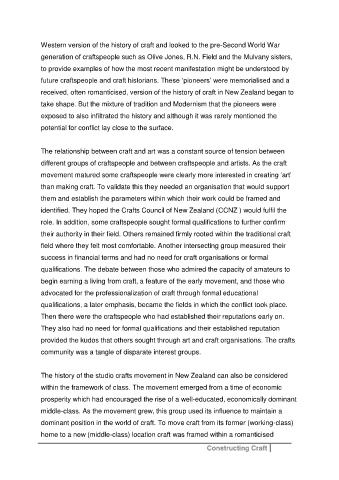Page 297 - Constructing Craft
P. 297
Western version of the history of craft and looked to the pre-Second World War
generation of craftspeople such as Olive Jones, R.N. Field and the Mulvany sisters,
to provide examples of how the most recent manifestation might be understood by
future craftspeople and craft historians. These ‘pioneers’ were memorialised and a
received, often romanticised, version of the history of craft in New Zealand began to
take shape. But the mixture of tradition and Modernism that the pioneers were
exposed to also infiltrated the history and although it was rarely mentioned the
potential for conflict lay close to the surface.
The relationship between craft and art was a constant source of tension between
different groups of craftspeople and between craftspeople and artists. As the craft
movement matured some craftspeople were clearly more interested in creating ‘art’
than making craft. To validate this they needed an organisation that would support
them and establish the parameters within which their work could be framed and
identified. They hoped the Crafts Council of New Zealand (CCNZ ) would fulfil the
role. In addition, some craftspeople sought formal qualifications to further confirm
their authority in their field. Others remained firmly rooted within the traditional craft
field where they felt most comfortable. Another intersecting group measured their
success in financial terms and had no need for craft organisations or formal
qualifications. The debate between those who admired the capacity of amateurs to
begin earning a living from craft, a feature of the early movement, and those who
advocated for the professionalization of craft through formal educational
qualifications, a later emphasis, became the fields in which the conflict took place.
Then there were the craftspeople who had established their reputations early on.
They also had no need for formal qualifications and their established reputation
provided the kudos that others sought through art and craft organisations. The crafts
community was a tangle of disparate interest groups.
The history of the studio crafts movement in New Zealand can also be considered
within the framework of class. The movement emerged from a time of economic
prosperity which had encouraged the rise of a well-educated, economically dominant
middle-class. As the movement grew, this group used its influence to maintain a
dominant position in the world of craft. To move craft from its former (working-class)
home to a new (middle-class) location craft was framed within a romanticised
Constructing Craft

